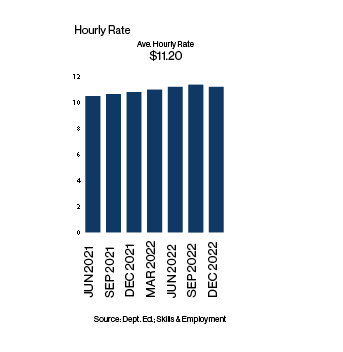)
Child Care Cost: Everything You Need to Know
Introduction to Child Care Cost
Child care is an essential service for many families, especially those where both parents work. The cost of child care, however, can be a significant burden. This article delves deep into the intricacies of child care costs, offering insights and practical advice for parents navigating this challenging terrain.
Understanding Child Care Cost
Child care costs vary widely based on several factors. It's not just about paying someone to watch over your child; it's about ensuring their safety, well-being, and development. Let's break down the various components that contribute to these costs.
Factors Influencing Child Care Cost
Types of Child Care Services: The kind of service you opt for can significantly impact the cost. For instance, specialized services like early education programs or facilities with advanced amenities might have a higher price tag.
Location and Regional Differences: Just like real estate, location matters. Urban areas, with higher living standards, often come with steeper child care costs than rural regions.
Age of the Child: Infants typically require more hands-on care than older kids, leading to higher costs.
Duration of Care: Full-time care will naturally cost more than part-time services.
Special Needs and Additional Services: Children with special needs or those requiring additional services like tutoring or therapy will have added costs.
Child Care Cost Trends and Data
According to the Department of Education, the average hourly fee for center-based childcare in Australia has seen a significant increase of 49% from September 2012 to September 2021. This rise took the cost from $7.10 to $10.50. It's essential to note that these figures represent the cost of care before any government assistance. The actual amount parents pay is adjusted by government subsidies.
From September 2012 to September 2021, barring five quarters, the average hourly fee for center-based care has generally shown positive growth. The year-on-year growth peaked at 7.45% in June 2016 and dipped to 2.0% in December 2020, largely due to the government assistance during the COVID-19 pandemic. As of September 2021, the year-on-year growth was 3.4%, with the average hourly fee at $10.55.
Between 2018 and 2022, childcare costs in Australia have surged. Fees increased across all services by 20% to 32%. When adjusted for inflation, the hikes were 4% for center-based and outside school hours care, 6% for family day care, and a whopping 15% for in-home care services.
The ACCC report sheds light on nominal fee changes since 2018:
- Centre-based daycare saw an increase of about $21 per day.
- Family day care fees rose by approximately $16 per day.
- Outside school hours care went up by around $5 per session.
- In-home care surged by about $74 per day.
Factors such as estimated income, location, the number of childcare providers, National Quality Standard ratings, and the size of childcare service providers influence the average fees households pay. Interestingly, regions with more childcare places and providers, like Major Cities and Inner and Outer Regional Australia, tend to have higher prices.
Contrary to conventional economic theory, areas with more providers of center-based daycare services have higher average fees. This could be attributed to these areas having relatively higher household income and socio-economic advantage, leading to a greater capacity to pay high childcare fees.
Providers take into account various factors when setting childcare fees, such as location, operational costs, inflation, staff wages, demand from parents, minimum occupancy levels, and competing services' prices. For-profit providers might also factor in their profitability.



Comparing Child Care Options
Daycare Centers vs. Home-based Care: While daycare centers offer structured environments and multiple caregivers, home-based care provides a homely atmosphere. The costs differ based on facilities, staff qualifications, and group sizes.
Nannies and Babysitters: Hiring a nanny or babysitter offers personalized care but can be more expensive, especially if you're seeking someone with specialized skills or experience.
Informal Care by Relatives or Friends: Often a cost-effective option, but it's essential to ensure that the caregiver can provide the necessary attention and care.
Benefits of Quality Child Care
Emotional and Social Development: Quality care ensures children develop essential emotional and social skills, preparing them for school and life.
Safety and Well-being: A good child care facility or caregiver prioritizes a child's safety and well-being, offering parents peace of mind.
Educational Advantages: Early education programs can set the foundation for lifelong learning, giving kids a head start.
Ways to Reduce Child Care Costs
Government Subsidies and Programs: Many governments offer subsidies or tax breaks to help offset child care costs.
Employer Benefits and Assistance: Some employers provide child care benefits or have tie-ups with local providers for discounted rates.
Sharing Care Responsibilities: Consider teaming up with other families to share a nanny or caregiver, reducing costs for everyone involved.
FAQs
How can I find affordable child care in my area?
Research local providers, ask for recommendations, and explore government or employer benefits.
Is it cheaper to hire a nanny or use a daycare center?
It depends on your needs, location, and the services offered. Always compare options before deciding.
Are there any tax breaks for child care?Many countries offer tax deductions or credits for child care expenses. Consult a local tax professional for guidance.
How do I ensure the quality of care if I'm paying less?
Always check references, reviews, and credentials. A lower cost doesn't necessarily mean compromised quality.
Can technology reduce child care costs?
Technology can offer tools for learning and monitoring, potentially reducing some costs. However, the human touch in child care remains irreplaceable.
What's the average child care cost for an infant?
Costs vary widely based on location, type of care, and duration. It's best to research local rates for the most accurate estimate.
Child care cost is a multifaceted issue, influenced by various factors. By understanding these elements and exploring different options, parents can make informed decisions that ensure their child's well-being without breaking the bank.
)
)
)
)
)
)
)
)
)
)
)
)
